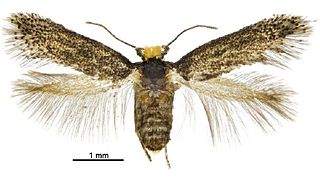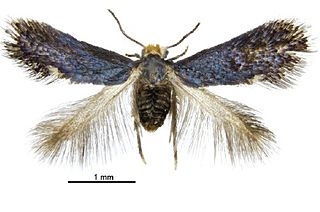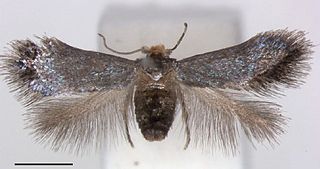
Stigmella ruficapitella is a moth of the family Nepticulidae. It is found in northern and central Europe. It is mostly absent in the Mediterranean region, with the exception of Mount Olympus in Greece and Trieste. It has recently been recorded from Russia and Bosnia.

Stigmella lapponica is a moth of the family Nepticulidae found in Asia, Europe and North America. It was first described by the German entomologist, Maximilian Ferdinand Wocke in 1862. The larvae mine the leaves of birch.

Stigmella plagicolella is a moth of the family Nepticulidae described by Henry Tibbats Stainton in 1854. It is found in all of Europe and the Near East.
Pectinivalva caenodora is a moth of the family Nepticulidae. It is found along the south-eastern coast of New South Wales.
Pectinivalva commoni is a moth of the family Nepticulidae. It is found along the south-western coast of Western Australia.
Pectinivalva endocapna is a moth of the family Nepticulidae. It is found along the south-western coast of Western Australia.
Pectinivalva libera is a moth of the family Nepticulidae. It is found along the southeastern coast of New South Wales.
Pectinivalva trepida is a moth of the family Nepticulidae. It is found along the south-eastern coast of Victoria.

Stigmella cypracma is a species of moth of the family Nepticulidae. It is endemic to New Zealand and has been observed in the North and South Islands. The larvae of this species are leaf miners and pupate within their mines. The larval host species is Brachyglottis repanda. Adult moths are on the wing in February and September to November. This species has two generations per year.

Stigmella fulva is a moth of the family Nepticulidae. It is endemic to New Zealand and has been observed in the North Island around Mount Taranaki, in the South Island and at Stewart Island. The species' eggs are laid singly but a considerable number may be deposited on the upper surface of one leaf. The incubation period can last from a week to a month depending on climatic conditions. The larvae mine the leaves of their host plants which are all in the genus Olearia. Larvae have been recorded in all months except January, February and June. The cocoon is brown and spun amongst the leaf litter under its host plant. The pupal period has been shown to range from 21 days to 79 days, again depending on climatic conditions. Adults have been observed on the wing January until March and August to December. They are active in the sun about their larval food plant.

Trifurcula cryptella is a moth of the family Nepticulidae. It is widespread throughout Europe, northwards to southern parts of Norway and Sweden, eastwards to Poland and the Balkan Peninsula, and south to the Mediterranean countries, but there it is rare and confined to mountainous regions. In Italy it has only been recorded from the northern part, in Portugal in the Serra da Estrêla, in Spain in the Cantabrian Mountains and possibly the Sierra Nevada. It is absent from the Mediterranean islands.
Stigmella montanotropica is a moth of the family Nepticulidae. It is found in tropical montane forest on the western slopes on the Andes in Ecuador.
Stigmella nubimontana is a moth of the family Nepticulidae. It is found in the cloud forest of the high Andes in Ecuador.

Pectinivalva mystaconota is a moth of the family Nepticulidae. It is known from scattered localities in eastern Australia from Wellington, New South Wales south to Mount Nelson, Hobart, Tasmania.

Pectinivalva minotaurus is a moth of the family Nepticulidae. It is found in southern Queensland.

Pectinivalva scotodes is a moth of the family Nepticulidae. It is found in New South Wales and southern Queensland.

Pectinivalva acmenae is a moth of the family Nepticulidae. It is found in New South Wales.

Pectinivalva quintiniae is a moth of the family Nepticulidae. It is found in northern New South Wales and southern Queensland.

Pectinivalva tribulatrix is a moth of the family Nepticulidae. It is found in northern Queensland.

Pectinivalva xenadelpha is a moth of the family Nepticulidae. It is found in Borneo, east Kalimantan.















